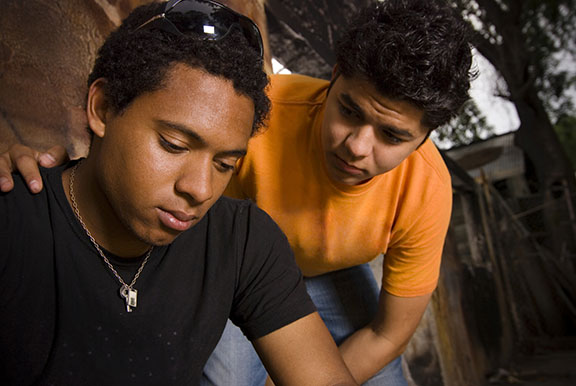Reaching All Victims
Some populations experience victimization at particularly high rates. Demographic, socioeconomic, cultural, and institutional obstacles may make it difficult for certain groups of victims to access services. For these individuals—including American Indians/Alaska Natives; individuals who identify as lesbian, gay, bisexual, transgender, or queer; boys and young men of color; older adults; runaway and homeless youth; and victims with disabilities—services may be unavailable, inadequate, or unknown. Furthermore, developments in technology have fostered opportunities to commit certain crimes, such as identity theft and financial fraud, in the expanse of cyberspace. These emerging issues present new challenges to the victim services field. In FYs 2013 and 2014, OVC increased its support for efforts to assist these vulnerable victim populations and develop comprehensive methods for providing them with the services they need. OVC’s efforts to support underserved communities include:
- Services for Transgender Victims of Sexual Assault
- Nationwide Network To Strengthen Services for Victims of Identity Theft
- Expansion of “Through Our Eyes” Video Series
- Enhancing Services to Young Men of Color
- The President’s Sexual Assault Task Force
Services for Transgender Victims of Sexual Assault
Transgender people experience extremely high rates of sexual violence, with approximately one in two being sexually abused or assaulted during their lifetimes.19 For too long, this population of victims has been marginalized and received minimal attention to their needs; yet transgender people are even less likely than other sexual assault survivors to access mainstream services because of fears of experiencing transphobia—the common practice of services’ segregation of clients by sex—and apprehension about encountering disbelief or unwarranted curiosity from criminal justice or sexual assault professionals.20
OVC funded FORGE—a nonprofit organization dedicated to advocating for the rights of transgender individuals and allies—to conduct four demonstration projects in sites around the country. The project generated Responding to Transgender Victims of Sexual Assault, an online guide to help educate those who respond to sexual assault victims about what it means to be transgender and how to provide these victims with accessible, appropriate care. Reflecting the perspectives of the transgender community, the online guide presents a wide array of information—from insight into the transgender experience to specific guidance for sexual assault service providers and advocates, law enforcement officers, medical and mental health care providers, and support group facilitators—in a user-friendly electronic format. It also includes practical tools to promote understanding and support of transgender victims, such as preferred language terms. The e-guide is designed to help victim service providers understand the needs of transgender survivors of sexual violence, provide appropriate services, and treat victims with respect.
Nationwide Network To Strengthen Services for Victims of Identity Theft
The National Identity Theft Victims Assistance Network (NITVAN) is a national network of coalitions focused on developing victim assistance training and outreach to enhance the ability of the members to provide direct services to victims of identity theft. Founded in 2010 with funding from OVC, NITVAN now provides several resources for victim assistance professionals, including victim advocates, attorneys, and law enforcement. In FY 2014, the OVC Training and Technical Assistance Center (OVC TTAC) began hosting these resources on its Web site. OVC TTAC’s Toolkit for Professionals provides strategies for improving and expanding services to victims of identity theft and forming a local coalition, as well as downloadable training materials and brochures that users can tailor to their own locations. NITVAN also offers a Resource Map with information about local agencies that offer legal services to identity theft victims, online legal self-help for clients in each state, professional identity theft networking opportunities, and state laws applicable to identity theft.
Expansion of “Through Our Eyes” Video Series
 According to a 2009 study conducted by the DOJ/OJP Office of Juvenile Justice and Delinquency Prevention, 60 percent of children experience violence, and even greater numbers are exposed to emotional abuse and maltreatment in their communities, schools, and homes.21 OVC’s Through Our Eyes: Children, Violence, and Trauma video series discusses how crime, abuse, violence, and trauma harm children and highlights promising and effective interventions to help children heal.
According to a 2009 study conducted by the DOJ/OJP Office of Juvenile Justice and Delinquency Prevention, 60 percent of children experience violence, and even greater numbers are exposed to emotional abuse and maltreatment in their communities, schools, and homes.21 OVC’s Through Our Eyes: Children, Violence, and Trauma video series discusses how crime, abuse, violence, and trauma harm children and highlights promising and effective interventions to help children heal.
Produced under the banner of the Defending Childhood Initiative, the series now includes eight videos and four posters that address a number of critical aspects of child victimization, including the serious and long-lasting consequences of violence on children’s physical and mental health; signs of exposure to trauma; the overwhelming cost of such maltreatment to families, communities, and the Nation; and the important role that community- and faith-based programs, services, and agencies play in protecting and helping children. A companion resource guide accompanies each video and directs users to related organizations, Web sites, and publications that describe the effects of violence and trauma on children and the benefits of proper support. Additionally, to facilitate access to the video series, OVC has expanded options for viewing the videos, all of which are available on YouTube and can be downloaded from the OVC Web site in three versions: QuickTime, Windows Media, and Closed Caption.
Enhancing Services to Young Men of Color
 Recognizing that few victim service organizations possess the necessary expertise and resources to provide comprehensive services to young men of color, OVC currently funds two demonstration projects22 that focus on providing services to these victims—particularly young African-American and Latino men, who are more likely to experience violent victimization than men of other ethnicities—to identify issues, promising practices, and innovative strategies that support these victims’ needs and help prevent retaliation and re-injury.
Recognizing that few victim service organizations possess the necessary expertise and resources to provide comprehensive services to young men of color, OVC currently funds two demonstration projects22 that focus on providing services to these victims—particularly young African-American and Latino men, who are more likely to experience violent victimization than men of other ethnicities—to identify issues, promising practices, and innovative strategies that support these victims’ needs and help prevent retaliation and re-injury.
In 2012, OVC began funding Drexel University’s Healing Hurt People program, which serves as the headquarters of the National Network of Hospital-based Violence Intervention Programs (NNHVIP), an international network of 27 hospital-based intervention programs that enhances existing hospital-based violence intervention programs and supports the development of emerging programs. NNHVIP ensures that intervention programs provide training, technical assistance, pilot testing, and evaluation regarding psychological trauma, which can have long-lasting effects on victims of physical violence. Healing Hurt People, which operates in three Philadelphia hospitals, has developed Web-based trauma training—with a toolkit and resources that users can tailor to their needs—and its Web site offers a variety of resources to allied professionals. The program also sponsors annual national symposiums on trauma intervention programs.
In Crown Heights (Brooklyn), OVC is supporting the Fund for City of New York and Center for Court Innovation’s Make It Happen! project, which is designed to connect high-risk youth with outreach workers who use motivational interviewing techniques and positive peer pressure to steer youth away from violence and toward healthy lifestyles. In 2012, OVC funded the Hidden Victims project of Make It Happen! that focused specifically on addressing the effects of psychological trauma. The Hidden Victims Project is establishing a support group that utilizes an empowerment curriculum based on best practices, conducting a community research study to document levels and types of victimization among high-risk youth, developing a trauma-informed toolkit, and creating a case management and referral protocol for victim service and mental health providers.
The President’s Sexual Assault Task Force
In response to the high rate of rape and sexual assault on college campuses, in January 2014, President Obama established the White House Task Force to Protect Students From Sexual Assault. Composed of officials throughout the executive branch of the Federal Government, the Task Force was charged with developing a coordinated federal response to rape and sexual assault at institutions of higher education and supporting efforts to enforce colleges’ and universities’ legal obligations to prevent and respond to these horrible crimes.
OVC leadership served on the Task Force and provided recommendations on how colleges and universities can prevent sexual assault and rape, enhance their support of survivors, and reach underserved victim populations. In May 2014, the Task Force launched NotAlone.gov, which offers data and resources—such as OVC’s Responding to Transgender Victims of Sexual Assault online guide—to assist with prevention efforts and responses to sexual assault on college campuses. In addition, OVC TTAC provided a series of Webinars on Title IX for victim advocates and state sexual assault coalition directors.








